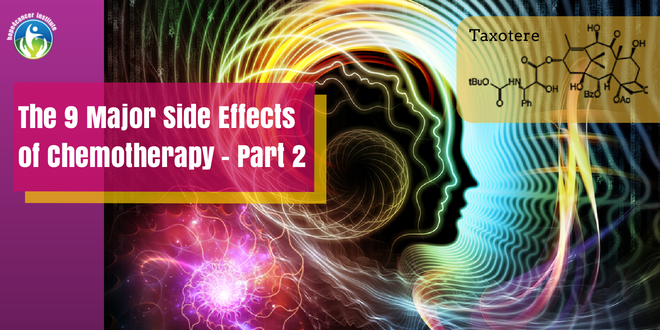The 9 Major Side Effects of Chemotherapy – Part II. How to Cope.
In the previous article on chemotherapy side effects, we described nine body systems that are directly affected by chemotherapy. What do oncologists recommend to patients to help them cope with its side effects? This article touches upon those interventions.
Alternatively, it also proposes to patients that they should make informed decisions about their treatments – taking all factors into consideration. In that context it is crucially important to bring into your radar the fact that modern treatments are available today that are both non-toxic and, at the same time, highly effective in treating cancer such as Sono-Photo Dynamic Therapy.
The side effects of chemotherapy are prevalent enough that there is a very large body of methods, both tested and untested, that claim to alleviate or reduce the limiting consequences of the treatment side effects. Some preventive methods are backed by dozens of research studies, while experts caution that others are more hit-or-miss. Here are some examples:
Ice chips for mouth sores: These painful sores, which can extend down the throat, are not only a nuisance—they can deter patients from eating and drinking, thereby affecting nutrition and energy levels.
Read About The 9 Major Side Effects of Chemotherapy – Part 1
But a simple measure might prevent mouth sores in some patients. A 2012 study in Iran of 80 patients indicated that those who placed ice or ice-cold water in their mouths from five minutes before starting to five minutes after completing a chemotherapy treatment had a 32.5 percent lower incidence of oral mucositis than those who had nothing in their mouths.
The intense cold is thought to temporarily narrow blood vessels in the mouth, a process called vasoconstriction, which diminishes blood supply, thereby reducing chemotherapy exposure for these cells. Additional research is needed, however. Also, if the cancer is affecting those areas, it is not know how constricting delivery of the therapy would affect its effectiveness.
Cold caps for hair loss and cold gloves for nail loss: Using the same tenets of vasoconstriction, deeply cooling the scalp or hands during chemotherapy can ward off hair or nail loss by temporarily hindering blood flow to those areas. While both methods are still being researched in the U.S., several European studies have shown some benefits.
A 2005 review of 53 studies on scalp cooling, published in the Annals of Oncology, for example, showed that the success rates of patients keeping their hair varied greatly, but “cooling time, the chemotherapy used and the temperature seem to be influential,” according to the authors.
While less prevalent than chemotherapy-associated hair loss, nail changes were the focus of a 2005 study that tested a so-called frozen glove on patients receiving docetaxel. Participants wore the glove on one hand and nothing on the other. According to the findings, 89 percent of the gloved hands had no nail toxicities compared with 49 percent in the non-gloved hands.
Learn More About Sono-Photo Dynamic Therapy
Cymbalta (duloxetine) or glutamine for neuropathy: One of the most common and difficult to handle chemotherapy side effects is peripheral neuropathy, a form of nerve damage that can range from mild to severe —from tingling in the hands and feet to electric shock-like pain. Such effects can hinder balance and activities of daily living, such as buttoning a shirt.
Neuropathy is usually temporary but can be long-lasting in some patients. In a phase 3 clinical trial published in the Journal of the American Medical Association, patients who took the antidepressant Cymbalta (duloxetine) reported a decrease in amount of neuropathic pain compared with those given a placebo —59 percent versus 38 percent.
Meanwhile, the amino acid glutamine has been shown to provide a protective effect on nerves. A small 2005 study of 46 patients treated with paclitaxel showed that those who took glutamine developed significantly less weakness, loss of “vibratory sensation” and toe numbness than those who did not take glutamine, but larger studies are needed to confirm this.
G-CSFs for low blood cell counts: Neutropenia, extremely low levels of neutrophils (a certain type of white blood cell), is a common result of most chemotherapy regimens. But plunging blood cell counts and the duration of this low point—which can invite life-threatening infections— can be as dangerous as cancer itself. Fever, which can sometimes be the only sign of infection, along with low neutrophil counts, is called febrile neutropenia.
Blood-forming molecules called granulocyte-colony stimulating factors (G-CSFs) can stimulate white blood cell proliferation, despite chemotherapy’s toxic effects. In a 2007 review of published randomized trials printed in the Journal of Clinical Oncology, researchers reported a 46 percent lower relative risk of febrile neutropenia in patients receiving G-CSFs compared with control patients.
Additionally, cutting the risk of neutropenia also lowers the chances of chemotherapy dose reductions or delays. In the past, patients required daily injections of a growth factor for several days after each dose of chemotherapy, but a long-acting preparation is now also available for use as a single injection per cycle of certain chemotherapy regimens.
The importance of non-toxic approaches to treating cancer: For the most part, patients are simply asked to deal with the side effects the best they can, because there are no concrete solutions. Read this article that scripts an interview with Dr. George Demetri, Director of the Center for Sarcoma and Bone Oncology at Dana-Farber Cancer Institute and Director of the Ludwig Center at Dana-Farber/Harvard Cancer Center, where he clearly identifies the shortcomings of cancer medicine over the past decades.
He also identifies the need for targeted therapies and smart drugs, which are apparently the “next wave” of personalized cancer medicine.
However, that type of medicine has been prescribed for years now at clinics that are at the leading edge of non-toxic cancer therapies in the world today, such as the Hope4Cancer Treatment Centers. Treatments such as Sono-Photo Dynamic Therapy available at Hope4Cancer Treatment Centers represents smart products that seek out tumor cells selectively, and have a method to destroy them without touching adjoining healthy cells.
These treatments are augmented by principle-based therapies that address the various aspects of the body’s terrain that cause cancer. Treating the whole body becomes an essential strategy that augment cancer-fighting treatments. This approach to cancer treatments is greatly neglected by the world of conventional medicine which explains why cancer treatments today in the world of mainstream medicine are largely ineffective and prone to serious side effects.


Thanks for explaining how cooling the scalp or hands during chemotherapy has been shown to prevent hair or nail loss by temporarily hindering blood flow to those areas. Since this is the case, using cold caps and gloves would be a great way to help people remain confident during their treatment. When purchasing cold caps or gloves, you’d probably want to research the different brands and options in order to find one that fits properly and which will work best to prevent hair or nail loss.